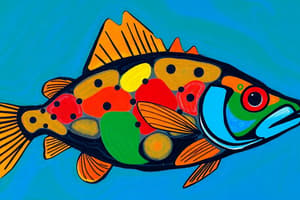Podcast
Questions and Answers
What separates true bony fish from other classes?
What separates true bony fish from other classes?
There are major differences that separate the true bony fish from the other classes.
What do members of the class Osteichthyes possess?
What do members of the class Osteichthyes possess?
Bony skeletons and often a swim bladder.
What supports the fins in fish?
What supports the fins in fish?
Either bone or cartilage.
What is the function of the anterior dorsal fin?
What is the function of the anterior dorsal fin?
How does the posterior dorsal fin compare to the anterior dorsal fin?
How does the posterior dorsal fin compare to the anterior dorsal fin?
Where is the anal fin located?
Where is the anal fin located?
What is the caudal fin?
What is the caudal fin?
What do most fish's bodies cover with?
What do most fish's bodies cover with?
What are chromatophores?
What are chromatophores?
Fish are unable to alter their color and pattern.
Fish are unable to alter their color and pattern.
What is countershading in fish?
What is countershading in fish?
How do fish ingest food?
How do fish ingest food?
What are gills?
What are gills?
How do fish obtain oxygen for cellular respiration?
How do fish obtain oxygen for cellular respiration?
What happens as water passes over the gills?
What happens as water passes over the gills?
What is a sensory canal in bony fish?
What is a sensory canal in bony fish?
What do the male sex organs produce?
What do the male sex organs produce?
What are proper conditions for spawning fish?
What are proper conditions for spawning fish?
Flashcards are hidden until you start studying
Study Notes
Class Osteichthyes (Bony Fish) Overview
- Major distinctions exist between true bony fish and other fish classes.
- Members of Osteichthyes possess bony skeletons.
Swim Bladder
- Many bony fish have a swim bladder, a thin-walled sac that aids in depth control without constant swimming.
- Gases in the swim bladder manage buoyancy, exchanged between the bloodstream and digestive system.
Fins
- Fish have two sets of paired fins, supported by either bone or cartilage.
- Anterior dorsal fin is located on the back, often with sharp spines, serving as a defensive mechanism.
- Posterior dorsal fin is smaller and softer, situated behind the anterior dorsal fin.
- The anal fin is positioned on the ventral surface behind the anal opening.
- Caudal fin, or tail fin, at the posterior end, propels the fish through water.
Body Covering and Coloration
- The body of most bony fish is covered with overlapping scales.
- Chromatophores are branched cells that produce pigments for fish coloration.
- Some fish can change color and patterns by rearranging pigments in chromatophores.
- Countershading serves as camouflage; the upper body is dark to blend with the bottom when viewed from above, and the lower body is light for blending with the surface when viewed from below.
Feeding and Respiration
- Fish ingest food through the mouth, which typically has teeth for catching or holding prey.
- Gills are the primary respiratory organs, allowing oxygen uptake from water, not from water molecules.
- Oxygen diffuses into blood vessels in the gills, while carbon dioxide waste diffuses out into the water.
Sensory Structures
- Bony fish have a lateral line system, a sensory canal running along each side of the body, enhancing their ability to detect movements and vibrations in water.
Reproduction
- Male testes produce sperm; females spawn eggs which are fertilized with milt from males.
- Successful spawning often requires favorable environmental conditions, including temperature changes, food availability, and water pH.
Studying That Suits You
Use AI to generate personalized quizzes and flashcards to suit your learning preferences.



